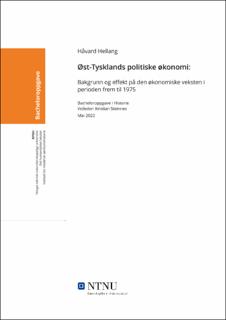| dc.contributor.advisor | Steinnes, Kristian | |
| dc.contributor.author | Hellang, Håvard | |
| dc.date.accessioned | 2022-09-20T17:20:06Z | |
| dc.date.available | 2022-09-20T17:20:06Z | |
| dc.date.issued | 2022 | |
| dc.identifier | no.ntnu:inspera:109090104:37588003 | |
| dc.identifier.uri | https://hdl.handle.net/11250/3019875 | |
| dc.description.abstract | Denne studien tar for seg det politisk-økonomiske systemet og den økonomiske veksten i Øst-Tyskland i perioden etter andre verdenskrig frem til ca midt på 1970 tallet. Den vil sammenligne hvordan de økonomiske strukturene som oppstod og utviklet seg i denne perioden var med på å påvirke den økonomiske veksten. De to sentrale systemene som undersøkes er planøkonomien og COMECON/CMEA. Studien tar ikke for seg geografi eller kultur, men fokuserer på hvordan politikk og økonomi er med på å forme de to økonomiske systemene og hvilken effekt de hadde på veksten til den østtyske økonomien. Studien tar for seg Acemoglu & Robinsons (2012) teori for hvordan politikk er med på å forme utviklingen av økonomiske strukturer. Studien tar for seg Øst-Tysklands geopolitiske posisjon og hvordan den har vært med på å forme hvordan de økonomiske systemene fungerer. Studien tar også for seg noen fordeler og ulemper de økonomiske systemene har gitt den østtyske økonomien med tanke på økonomisk vekst. Den ser også på hvordan systemene har bidratt til å takle noen store omstillinger som økonomien sto ovenfor.
Studien konkluderer med at politiske hensyn kan ha hatt mer å si for utformingen av planøkonomien og COMECON enn økonomiske hensyn. Dette til tross for at det er økonomiske systemer. Videre konkluderer studien med at det kan tyde på at de økonomiske systemene hadde en positiv effekt på veksten i den østtyske økonomien i det korte bildet, men at de kan ha skapt større problemer i det lengre bildet. Studien går ikke kvantitativt til verks, og kan derfor ikke konkludere med noe definitivt. Den finner også at de politiske strømningene kan ha hatt en effekt på den økonomiske utviklingen, og at i perioden med liberalisering under Khrusjtsjov var bedre for økonomisk vekst enn perioden etterpå. | |
| dc.description.abstract | This study looks into the political economic system and the economic growth in Eastern Germany in the period after the second world war up until ca the mid-1970s. It will compare how the economic structures that formed and developed in this period effected the economic growth of Eastern Germany. The two central systems being investigated is the planned economy and COMECON/CMEA. The study does not look at either geography or culture, but focuses on how politics and economy takes part in forming the economic structures, and the effect it have on the economic growth of the East German economy. The study also incorporates Acemoglu & Robinsons (2012) theory on how politics have a profound effect on how economic structures are formed. The study also takes a look at how the geopolitical situation influenced the way the economic systems functioned. The study also gives some positive and negative effects the economic systems gave the growth of the East German economy. It also looks at some of what the systems did for the economy during some of the major changes the East German economy faced.
The study concludes that political priorities may have been the deciding factor during the formation of the planed economy and COMECON, rather than economic priorities. This despite the fact that these are economic systems. Furthermore, it concludes that the economic systems may have had a positive effect on the economic growth in the short term, but possibly created bigger economic problems on the longer term. This study does not work quantitatively and can therefore not conclude anything with a high degree of certainty. The study also finds that the political currents in the Soviet Union may have influenced the economic growth, and that the period of liberalisation under Khrushchev where better for the economic growth than the following period. | |
| dc.language | nob | |
| dc.publisher | NTNU | |
| dc.title | Øst-Tysklands politiske økonomi: bakgrunn og effekt på den økonomiske veksten i perioden frem til 1975 | |
| dc.type | Bachelor thesis | |
